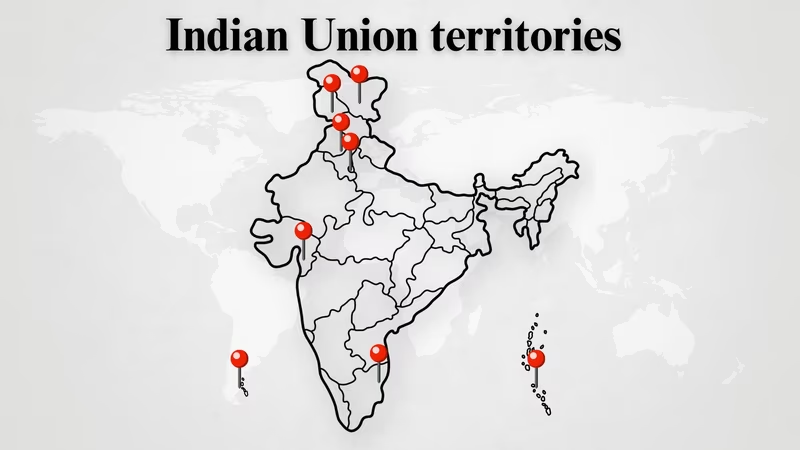When we talk about India’s political map, we often focus on its 28 states, but there’s another fascinating layer: the 8 Union Territories of India.
These territories don’t have the same level of autonomy as states; instead, they’re governed directly by the Central Government.
Each one has a unique reason for existing, whether it’s strategic importance, historical background, or administrative convenience. Let’s break down what makes them special.
What Is Territories In India?
A territory is an area that comes under the direct administration of the Union Government of India.
Unlike states, which have their own elected governments and chief ministers, most UTs are managed by an administrator or lieutenant governor appointed by the president.
Only Delhi, Puducherry, and Jammu & Kashmir have their own legislatures, giving them limited self-rule.
The rest function under the guidance of the central government for better coordination, uniform governance, or strategic control.
History of Union Territories in India
The concept of Union Territories in India originated after Independence when certain regions were too small, strategically important, or culturally distinct to function as full-fledged states.
Initially, these areas were classified as Part C and Part D states, administered directly by the centre.
The States Reorganisation Act, 1956 formally created the category of Union Territories.
Over time, several changes took place: some UTs were granted statehood (like Himachal Pradesh, Goa, and Mizoram), while new ones were formed (like Chandigarh in 1966 and Ladakh in 2019).
Dadra & Nagar Haveli and Daman & Diu were merged in 2020 into a single UT. Today, UTs remain important administrative units for regions that require direct central oversight.
Constitutional Status of Territories in India
Union Territories fall under Part VIII of the Indian Constitution (Articles 239 to 242). Unlike states, UTs do not have the same degree of federal autonomy.
They are administered by the President of India through appointed Lieutenant Governors or Administrators.
Article 1 of the Constitution recognises Union Territories as part of the “territory of India.”
Parliament has the authority to make laws for UTs on all subjects, although some UTs like Delhi, Puducherry, and Jammu & Kashmir have their own legislative assemblies with limited powers.
Why Are They Called Union Territories?
The term “Union Territory” literally means that these regions belong to the Union (Central) Government.
Since these territories don’t have full statehood, they are governed directly by the Union of India, ensuring consistency in administration.
This setup often helps maintain national security, unity, and equal development in smaller or strategically significant regions.
Discover which Indian cities shine in wealth and growth in the Full List of Richest Cities in India (2025).
Explanation of the UT of India
Here’s a closer look at each UT of India, their capitals, features, and what makes them unique.
1. Andaman and Nicobar Islands
- Capital: Port Blair
- Key Features: This is a group of over 500 islands in the Bay of Bengal. It is known for its tropical rainforests, beautiful white-sand beaches, and vibrant coral reefs that are home to diverse marine life.
- The historic Cellular Jail, used during India's freedom struggle, is a significant landmark here.
2. Chandigarh
- Capital: Chandigarh
- Key Features: Known for its modern architecture and urban design, Chandigarh is a well-planned city. It serves as the joint capital for the states of Punjab and Haryana while being a UT itself.
- It is famous for its clean roads, gardens like the Zakir Hussain Rose Garden, and unique attractions like the Rock Garden.
3. Dadra and Nagar Haveli and Daman and Diu
- Capital: Daman
- Key Features: Located in western India, this territory was formed by merging two former UTs in 2020. It is known for its Portuguese colonial heritage, which is visible in its forts and churches.
- The territory offers peaceful beaches and pleasant weather, making it a popular tourist spot.
4. Delhi (National Capital Territory of Delhi)
- Capital: New Delhi
- Key Features: Delhi is the national capital and a major political, cultural, and commercial center. It is a historic city with many famous monuments like India Gate, Humayun's Tomb, and the Red Fort.
- Although it is a UT, Delhi has its own elected legislature and government to manage its affairs.
5. Jammu and Kashmir
- Capital: Srinagar (Summer), Jammu (Winter)
- Key Features: This Union Territory is located in the northern part of India and is known for its stunning natural beauty, including mountains, valleys, and lakes like the famous Dal Lake.
- It also has a rich cultural history and is famous for its traditional handicrafts, such as Pashmina shawls and carpets.
6. Ladakh
- Capital: Leh
- Key Features: Situated in the high-altitude Himalayan region, Ladakh is famous for its dramatic landscapes, Buddhist monasteries, and unique culture. It became a Union Territory in 2019.
- It is often called a "cold desert" and is a popular destination for adventure tourism and trekking.
7. Lakshadweep
- Capital: Kavaratti
- Key Features: This is an archipelago of 36 coral islands in the Arabian Sea and is India's smallest Union Territory.
- It is known for its pristine beaches, clear turquoise lagoons, and rich marine life, making it an ideal place for water sports like snorkeling and scuba diving.
8. Puducherry
- Capital: Puducherry
- Key Features: This territory is known for its French colonial past, which is visible in its architecture and town planning.
- It consists of four separate districts and has a unique Franco-Tamil culture. The French Quarter, with its charming streets and cafes, is a major attraction.
Each UT has a Lieutenant Governor (appointed by the President) except Delhi and J&K, which have Chief Ministers. Delhi, J&K, and Puducherry have elected assemblies. The others are run directly by New Delhi.
Find out which states lead India’s economy in the List of Richest States in India (2025).
Comparison of the Union Territories in india
| Union Territory | Capital | Area (sq. km) | A Key Highlight |
| Andaman & Nicobar Islands | Port Blair | 8,249 | A large group of tropical islands |
| Chandigarh | Chandigarh | 114 | A well-planned modern city |
| Dadra & Nagar Haveli and Daman & Diu | Daman | 603 | Known for its Portuguese history |
| Delhi (NCT) | New Delhi | 1,484 | The National Capital of India |
| Jammu and Kashmir | Srinagar (S), Jammu (W) | 42,241 | Famous for its scenic Himalayan beauty |
| Ladakh | Leh | 59,146 | A high-altitude desert region |
| Lakshadweep | Kavaratti | 32 | India's only coral island chain |
| Puducherry | Puducherry | 479 | Known for its French colonial architecture |
Why Only These Are Called Union Territories in India
Not all regions in India are suitable for full statehood. The following reasons explain why some are Union Territories instead of states:
- Strategic Location: Border areas or islands like Ladakh and Andaman & Nicobar need direct control for defense and security.
- Shared Capital: Chandigarh serves as the capital for both Punjab and Haryana, so it’s a UT to maintain neutrality.
- Historical Background: Regions like Puducherry and Daman & Diu were once European colonies; hence, they remained separate after integration.
- Administrative Convenience: Smaller regions or areas with unique identities and population sizes are easier to manage as Union Territories.
Know all about India’s states and what makes each one unique; read our blog on States in India.
The Administrative System of Union Territories in India
The administration of Union Territories varies based on whether the UT has a legislature or not.
Union Territories without a legislature, such as Andaman & Nicobar Islands, Lakshadweep, Chandigarh, and Dadra & Nagar Haveli and Daman & Diu, are governed directly by the Central Government through an Administrator or Lieutenant Governor.
Union Territories with a legislature Delhi, Puducherry, and Jammu & Kashmir follow a hybrid administrative model.
They have an elected legislative assembly and a chief minister, but the lieutenant governor holds significant powers, especially over subjects like public order, land, police, and other matters where the center has a direct role.
Lt. Governors & Administrators of Union Territories in India
Below is the updated list of Lieutenant Governors and Administrators of India’s Union Territories for 2025:
- Andaman & Nicobar Islands – Admiral D.K. Joshi (Retd.)
- Delhi (NCT) – Vinai Kumar Saxena
- Jammu & Kashmir – Manoj Sinha
- Ladakh – Brig. (Retd.) B.D. Mishra
- Puducherry – K. Kailashnathan
- Chandigarh – Gulab Chand Kataria
- Dadra & Nagar Haveli and Daman & Diu – Praful Khoda Patel
- Lakshadweep – Praful Khoda Patel (additional charge)
Difference Between States and Union Territories
States have their own elected governments with full legislative powers, while Union Territories are administered by the Central Government.
States enjoy greater autonomy and control over police, land, and public order, whereas in most UTs these subjects remain under the Centre.
States are governed under Part VI of the Constitution, while Union Territories come under Part VIII. States have their own Governors, Chief Ministers, and councils of ministers.
UTs, on the other hand, are administered by Lieutenant Governors or Administrators appointed by the President. Only a few UTs have legislative assemblies, and even they operate with limited powers compared to states.
The 8 Union Territories of India together show the diversity and administrative flexibility of the country.
Some exist for strategic reasons, others for historical or cultural uniqueness, but all are integral parts of the Union of India.
So the next time you see India’s map, look beyond the states and discover how these Union Territories help the Union stay united, powerful, and beautifully complex.
Don’t just save, shine! Grow your wealth effortlessly in digital gold on Jar.
Frequently Asked Questions (FAQs)
Are Jammu and Kashmir different Union Territories?
Yes. The former state of Jammu and Kashmir was reorganized on October 31, 2019, into two separate Union Territories: the Union Territory of Jammu and Kashmir and the Union Territory of Ladakh.
Is Jammu and Kashmir a state or a union territory?
As of now, Jammu and Kashmir is a Union Territory. However, it has been established with its own legislature (like Delhi), and there is a possibility for it to become a state again in the future.
Are there 8 or 9 Union Territories in India?
There are currently 8 Union Territories. The number briefly became 9 after Jammu & Kashmir and Ladakh were formed. However, in January 2020, the UTs of Dadra and Nagar Haveli and Daman and Diu were merged into one, bringing the total back down to 8.
Why was the state of Jammu & Kashmir divided?
The Indian Parliament reorganized the state for reasons of governance, development, and security. Creating two UTs allows for more focused administration for the very different regions of Jammu & Kashmir and Ladakh.
Why is Puducherry a union territory?
Puducherry was a French colony for a long time. After it joined India in 1954, it was made a Union Territory to preserve its unique French cultural identity and heritage, which are distinct from the surrounding state of Tamil Nadu.
When did Ladakh become a Union Territory?
Ladakh officially became a Union Territory on October 31, 2019, after being separated from the former state of Jammu and Kashmir.
Why is Jammu and Kashmir not a state right now?
It was converted from a state to a Union Territory in 2019 to allow the central government to have more direct oversight over its administration, with the stated goals of improving security and boosting development in the region.










